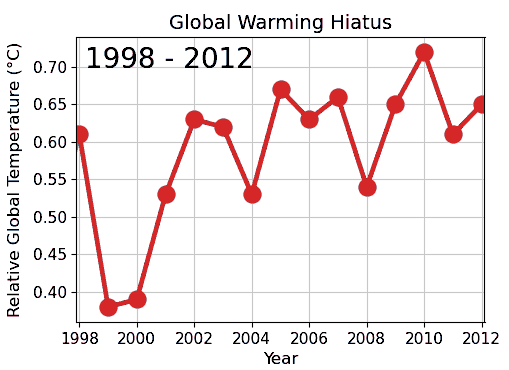# This source code is public domain
import numpy
import matplotlib.pyplot as plt
import imageio
year_T = {
# https://data.giss.nasa.gov/gistemp/tabledata_v4/GLB.Ts+dSST.txt
# GLOBAL Land-Ocean Temperature Index in 0.01 degrees Celsius base period: 1951-1980
# sources: GHCN-v4 1880-07/2021 + SST: ERSST v5 1880-07/2021
# using elimination of outliers and homogeneity adjustment
# Divide by 100 to get changes in degrees Celsius (deg-C).
# Year J-D (annual mean Temperature Jan to Dec)
1880: -16, 1881: -8, 1882: -11, 1883: -17, 1884: -28,
1885: -33, 1886: -31, 1887: -36, 1888: -17, 1889: -10,
1890: -35, 1891: -22, 1892: -27, 1893: -31, 1894: -30,
1895: -22, 1896: -11, 1897: -11, 1898: -27, 1899: -17,
1900: -8, 1901: -15, 1902: -28, 1903: -37, 1904: -47,
1905: -26, 1906: -22, 1907: -38, 1908: -43, 1909: -48,
1910: -43, 1911: -44, 1912: -36, 1913: -34, 1914: -15,
1915: -14, 1916: -36, 1917: -46, 1918: -30, 1919: -28,
1920: -27, 1921: -19, 1922: -29, 1923: -27, 1924: -27,
1925: -22, 1926: -11, 1927: -22, 1928: -20, 1929: -36,
1930: -16, 1931: -9, 1932: -16, 1933: -29, 1934: -13,
1935: -20, 1936: -15, 1937: -3, 1938: 0, 1939: -2,
1940: 13, 1941: 19, 1942: 7, 1943: 9, 1944: 20,
1945: 9, 1946: -7, 1947: -3, 1948: -11, 1949: -11,
1950: -17, 1951: -7, 1952: 1, 1953: 8, 1954: -13,
1955: -14, 1956: -19, 1957: 5, 1958: 6, 1959: 3,
1960: -3, 1961: 6, 1962: 3, 1963: 5, 1964: -20,
1965: -11, 1966: -6, 1967: -2, 1968: -8, 1969: 5,
1970: 3, 1971: -8, 1972: 1, 1973: 16, 1974: -7,
1975: -1, 1976: -10, 1977: 18, 1978: 7, 1979: 16,
1980: 26, 1981: 32, 1982: 14, 1983: 31, 1984: 16,
1985: 12, 1986: 18, 1987: 32, 1988: 39, 1989: 27,
1990: 45, 1991: 40, 1992: 22, 1993: 23, 1994: 31,
1995: 45, 1996: 33, 1997: 46, 1998: 61, 1999: 38,
2000: 39, 2001: 53, 2002: 63, 2003: 62, 2004: 53,
2005: 67, 2006: 63, 2007: 66, 2008: 54, 2009: 65,
2010: 72, 2011: 61, 2012: 65, 2013: 67, 2014: 74,
2015: 90, 2016: 101, 2017: 92, 2018: 85, 2019: 97,
2020: 102, 2021: 85, 2022: 89,
}
x, y = (numpy.array(list(x()), dtype='d') for x in (year_T.keys, year_T.values))
y = y / 100
xMinFocus, xMaxFocus = 1998, 2012
i0 = x.tolist().index(xMinFocus)
i1 = x.tolist().index(xMaxFocus) + 1
nPoly = 4
phi = numpy.array([x**i for i in range(nPoly)])
A = phi @ phi.T
b = phi @ y
c = numpy.linalg.solve(A, b)
yPoly = c @ phi
phiHist = phi[:,:i1]
A = phiHist @ phiHist.T
b = phiHist @ y[:i1]
c = numpy.linalg.solve(A, b)
yPolyHist = c @ phi
nPoly = 3
phiF = phi[:nPoly,i0:i1]
A = phiF @ phiF.T
b = phiF @ y[i0:i1]
c = numpy.linalg.solve(A, b)
yPolyFocus = c @ phi[:nPoly]
yMinTotal, yMaxTotal = numpy.min(y) - 0.02, numpy.max(y) + 0.02
xMinTotal, xMaxTotal = numpy.min(x), numpy.max(x)
yMinFocus, yMaxFocus = numpy.min(y[i0:i1]) - 0.02, numpy.max(y[i0:i1]) + 0.02
plt.xlim(xMinFocus-0.1, xMaxFocus+0.1)
# Frame-Parameter:
# t: Frame duration
# trans1: transition 0 to 1 towards full time frame
# trans2: transition 0 to 1 towards full data set
# showTrend: Trend (0: None, 1: Zoom, 2: full history, 3: full time frame)
parameters = [ # (t, trans1, trans2, showTrend)
(1, 0.0, 0.0, 0),
(4, 0.0, 0.0, 1),
*[(0.1, t**2, 0.0, 1) for t in numpy.linspace(0,1,25)],
(1.0, 1.0, 0.0, 1),
(0.5, 1.0, 0.0, 0),
(1, 1.0, 0.0, 2),
*[(0.1, 1.0, t,2) for t in numpy.linspace(0,1,10)],
(0.5, 1.0, 1.0, 2),
(6, 1.0, 1.0, 3),
]
images = []
duration = []
for t, trans1, trans2, showTrend in parameters:
duration.append(t)
zoom = 4*(1-trans1) + 1*trans1
fig = plt.figure(figsize=(5.1,3.7), dpi=100)
plt.rc('axes', titlesize=14, labelsize=12)
plt.rc('xtick', labelsize=11)
plt.rc('ytick', labelsize=11)
plt.rc('legend', fontsize=16)
if showTrend == 1: plt.plot(x[i0-15:], yPolyFocus[i0-15:], 'r--', label='Trend')
if showTrend == 2: plt.plot(x, yPolyHist, 'b--', label='Trend')
if showTrend == 3: plt.plot(x, yPoly, 'b--', label='Trend')
iMax = int(i1 + trans2*(len(x)-i1))
plt.plot(x[:iMax], y[:iMax], 'C0.-', alpha=0.8, linewidth=0.8*zoom, markersize=6*zoom)
plt.plot(x[i0:i1], y[i0:i1], 'C3.-', linewidth=0.805*zoom, markersize=6.05*zoom)
plt.grid(True, alpha=0.7)
yMax = yMaxFocus + trans1*(yMaxTotal-yMaxFocus)
xMax = xMaxFocus + trans1*(xMaxTotal-xMaxFocus)
xMin = xMinFocus*(1-trans1) + xMinTotal*trans1
plt.xlim(xMin-0.1, xMax+0.1+1*trans1)
plt.ylim(yMinFocus*(1-trans1) + yMinTotal*trans1, yMaxFocus*(1-trans1) + yMax*trans1+0.03*trans1)
plt.text(0.02, 0.89, '%i - %i'%(xMin, x[iMax-1]), transform=plt.gca().transAxes, fontsize=20)
plt.title('Global Warming Hiatus')
plt.xlabel('Year')
plt.ylabel('Relative Global Temperature (°C)')
plt.gca().yaxis.set_label_coords(-0.13, 0.5)
if showTrend: leg = plt.legend(frameon=False, loc='lower right')
fig.subplots_adjust(
top=0.9,
bottom=0.13,
left=0.15,
right=0.95,
hspace=0.2,
wspace=0.2
)
fig.canvas.draw()
s, (width, height) = fig.canvas.print_to_buffer()
images.append(numpy.array(list(s), numpy.uint8).reshape((height, width, 4)))
fig.clf()
plt.close('all')
# Save GIF animation
fileOut = 'Global_warming_hiatus.gif'
imageio.mimsave(fileOut, images, duration=duration)
# Optimize GIF size
from pygifsicle import optimize
optimize(fileOut, colors=20)






